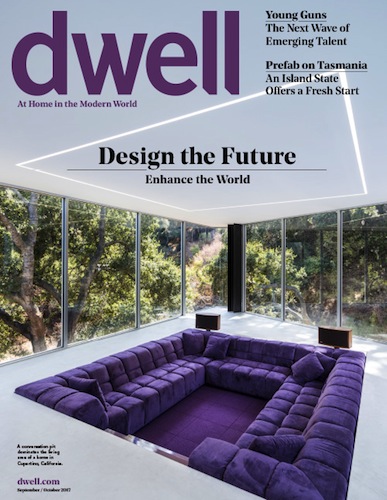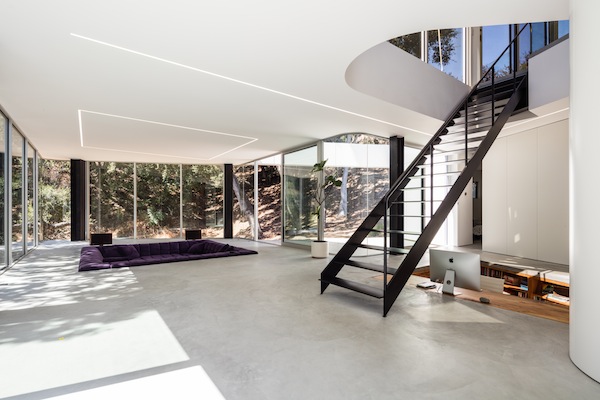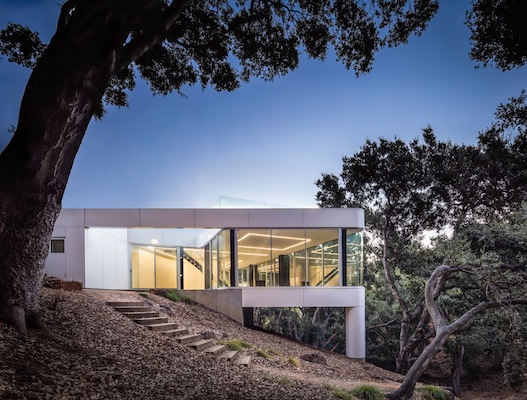
A Pair of Bose 901s in a 21st-Century California Home

It took me a moment to realize that the loudspeakers behind the conversation pit of the 21st-century California home that is the subject of the cover story of the September/October issue of Dwell magazine were venerable Bose 901s.
I not only bought the issue; I took out a subscription.
Dwell‘s cover-story house (Craig Steely, architect) will not appear on the cover of This Old House, at least any time soon. (Give it 100 years.) Very cutting-edge in its details, such as the curved corners of the glass walls and the LED ceiling strip lights that set off different areas, the house nonetheless adheres firmly to the Mid-Century-Modern precept of siting the home within nature, rather than in opposition to it. The first similar design was Mies van der Rohe‘s see-though glass-walled Farnsworth House, built for Dr. Edith Farnsworth.
OK… But–how did the 901s get into a 21st-century house?
For that, some background on the 901, and my thoughts about the architectural-acoustical aspects of the design, please click the jump link.
 Courtesy Craig Steely Architecture
Courtesy Craig Steely Architecture
I pondered the matter and decided that, contrary to snap judgment based on intuition, the setup was entirely valid.
Consultants on architectural acoustics (such as I) usually react to a design with huge glass walls with a sad shaking of the head. However, emplacing 901s somewhat equidistant from the side and rear walls will let them play as designed. The sound will be retro and somewhat swimmy, but enveloping in a way that more modern and conventional systems cannot deliver. On balance, I think that working with the acoustics the room has, rather than against them, was the wiser choice.
I sent the following LTE to Dwell, and then forwarded it to Craig Steely:
Editor:
The cover photo of your September/October 2017 issue (cover story: “A glass house floats at the edge of Silicon Valley”) actually gave me a pang of nostalgia (believe it or not).
I expect that most of your readers might not realize that the two objects at the rear of the conversation pit (which appear to be wooden boxes, with black-fabric fronts) are, almost certainly, early models of Bose’s flagship model 901 direct/reflecting loudspeaker.
The Bose 901 was introduced in 1968 (and it remains in production today). I still remember Julian Hirsch’s unprecedentedly positive review of the 901 in the September 1968 issue of Stereo Review. That’s a memory that is as fresh for me today as though I had picked that issue up at the newsstand yesterday.
One might be tempted to think that it would be a mistake to install such retro 1960s loudspeakers in a 21st-century house (even while acknowledging that the house’s design does pay homage to the Case Study houses).
However, I work as a consultant on architectural acoustics and audio-system design. I think putting Bose 901s at the edge of the conversation pit is a brilliant idea.
Amar Bose, while a graduate student at MIT, bought himself, as a bit of a self-reward, a new stereo. Once he got it home, however, he did not like its sound. Bose (rightly or wrongly) decided that the reason that his new stereo didn’t sound all that good to him was that its propagation of an acoustical wave front within a living room did not mimic the behavior of the sound of the Boston Symphony playing in Symphony Hall.
That is why the back panel of the Bose 901 is split in two, and each half is slightly angled to the outside (for broader dispersion). Each speaker’s back panel contains in total eight identical drivers, while the front baffle contains only one driver. The goal was to establish, in the owner’s listening room, Bose’s desired balance of the late-arriving reflected sounds’ being almost 90% of the total perceived sound.
Bose’s thesis as to the proper balance of direct versus reflected sound in a playback room has been a matter of controversy (and sometimes, an object of scorn) for almost 50 years.
That said, there is no question in my mind that the designer of the playback system in your cover-story house made the right decision to work with the acoustics that the room unalterably has, rather than to fight against them.
I do think that the playback sound in that room might not compete with a modern system in a conventional room, at least in terms of timbral accuracy, dynamic capability, or image specificity.
However, I am equally certain that the cover-story house conversation-pit system, owing to its bouncing most of its sound output off reflective surfaces to the rear (the task for which the 901’s proprietary equalization curve was designed), should be able to deliver that wondrous (but elusive) sense of being enveloped in the music.
John Marks
Classical music record producer, audio engineer, and system designer.
Craig Steely promptly replied that he was glad that someone had noticed that particular detail. He went on to say that he had found that pair of 901s left out on the street in San Francisco. The owner of the glass-walled house restored the speakers, and acquired the necessary external equalization boxes.
Here’s another photo:
 Courtesy Craig Steely Architecture
Courtesy Craig Steely Architecture
# # #



As a speaker designer and a competitor, I have had a lot of experience with the Bose 901. Its design has several good points. Its overall frequency response (in a reverberant room) is very flat. The use of a reflected sound field is psycho-acoustically beneficial. The nine 4.25″ drivers add up to about a 10″ woofer at low frequencies, so there is ability to move air at low frequencies. Most listeners do not notice the distortion caused by the limited suspension and short voice coil.
The equalization makes up for the drivers’ lack of high-frequency reproduction at the expense of being very shrill on axis with the driver. Again, fortunately, most listeners have lost their hearing at those frequencies.